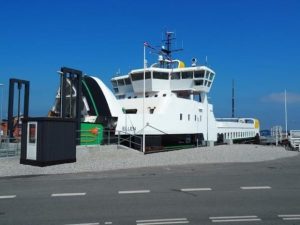In the waters of the Rhine River, near Bonn, the electric river ferry Mondorf no longer leaves a trail of black smoke or vibrates with the diesel roar. Since February 2025, its engines were replaced by a 290 kW (400 HP) electric propulsion, leading to a new paradigm in river transportation: clean, silent, and safer.
This ferry, which crosses a 400-meter stretch of the river in just two minutes, gets its energy from a 1,000 kWh battery, equivalent to that of 14 electric cars. It recharges overnight at the dock with electricity from renewable sources, and operates about 14 hours a day using around 600 kWh daily.
The conversion of this 60-year-old vessel was made possible thanks to the support of the German government, which funded up to 80% of the project. Lux-Werft und Schifffahrt GmbH, the company behind the conversion, has already converted about 20 passenger ships, showing a strong commitment to sustainable river mobility.
Less Maintenance, More Efficiency
In addition to being more environmentally friendly, electric motors require less maintenance than traditional ones. In the long term, this could mean lower operating costs, even in the face of high electricity prices in Germany. The electric system does not require flammable fuels, making it safer for both people and the aquatic ecosystem.
“Everything is simpler and safer. There are no pollution risks during refueling, and the system does not depend on fossil fuels,” said Schneider-Lux, the company’s operations manager.
This trend is not limited to Germany. According to the Maritime Battery Forum, there are already over 1,000 electric or hybrid ships sailing worldwide, with more than 460 currently under construction. Norway is the undisputed leader: over 80 of its ferries operate with electricity thanks to state policies that incentivize emissions-free navigation.

Environmental Benefits of Electric Ships
The advancement of electric propulsion in river and maritime transportation represents a positive change for the environment:
- Emission Reduction: Maritime transport accounts for about 2.8% of global CO₂ emissions. Electric ships completely eliminate direct emissions.
- Zero Toxic Discharges: By eliminating diesel, the risks of fuel spills in rivers, lakes, and seas are reduced.
- Less Acoustic Pollution: Silent navigation reduces stress and impact on marine fauna.
- Cleaner Air in Port Areas: Particularly important in urban areas near rivers or coasts, where air quality significantly improves.
- Reuse of Renewable Energy: Many electric ships recharge with wind, solar, or hydroelectricity, closing the ecological cycle.
Moreover, on short routes, these vessels are already economically competitive, demonstrating that sustainability and profitability can go hand in hand.
Buquebús to Have the World’s Largest 100% Electric Ferry
The company Incat Tasmania announced that it has started building the world’s largest 100% electric ferry. It will be 130 meters long and have the capacity to transport 2,100 passengers and 226 vehicles. The news is significant in Argentina because the company that ordered this ferry is Buquebús, owned by businessman Juan Carlos López Mena, who dominates the market for river transportation in the Río de la Plata.
In addition to being a fan of Mercedes-AMG cars (see note), López Mena is also known for always wanting to offer the latest technology on his private and commercial ships.
The news of Buquebús’ new ferry was confirmed by the shipyard Incat Tasmania, which has already started the construction of the vessel in Oceania and expects to deliver it by the year 2025.
Source: DW.

